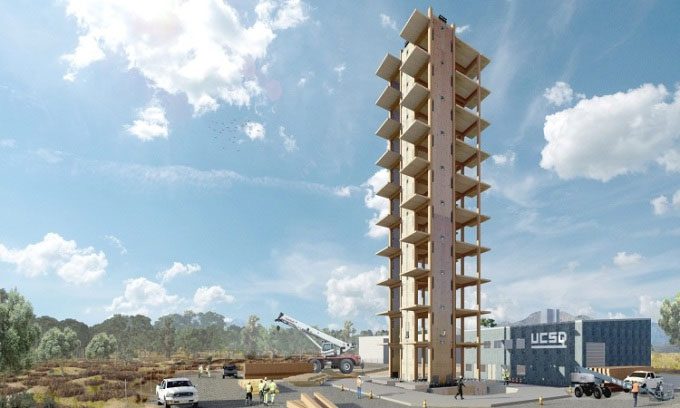Researchers Construct a 10-Story Wooden Building to Test Earthquake Resilience.
For nearly two decades, the University of California San Diego has possessed a crucial tool for understanding earthquakes. This is a steel frame measuring 12.1 x 7.6 meters, which uses a hydraulic system to simulate seismic movements. However, for the past nine months, the platform has remained stationary as researchers prepare for an unprecedented experiment. This involves testing a 10-story wooden building as part of the TallWood project, reported by Popular Science on March 7.

Design of the 10-story TallWood building. (Photo: NHERI).
According to lead researcher Shiling Pei, the goal of the TallWood project is to demonstrate that wooden buildings can withstand strong tremors without losing the structural integrity of the framework. With lower carbon emissions than concrete or steel, wood has become an increasingly popular choice in recent years as a sustainable building material. Additionally, the flexibility of the structure makes wood particularly suitable for earthquake resistance; for example, branches can bend without breaking. “Using current technology, we can construct a 10-story building that remains resilient after earthquakes. Our plan is for the building to undergo 40 seismic tests, and we hope it will not suffer any structural damage,” Pei shared.
Pei, a professor of environmental engineering at the Colorado School of Mines, specializes in wood systems and risk mitigation through engineering, making him a perfect fit for this project. However, Pei is just one member of an interdisciplinary team that has been working on the project since 2016, as part of the National Science Foundation’s Natural Hazards Engineering Research Infrastructure (NHERI) program. The team includes professors from six universities, over two dozen industry partners, the U.S. Forest Service, and various other government agencies.
The research team first proposed the wooden design for testing in 2017, constructing a two-story wooden building for the shaking table. The building successfully withstood about 30 “earthquakes,” including movements simulating the 6.7 magnitude Northridge earthquake that occurred nearly three decades ago in California.
The 10-story TallWood project builds on that research. At the core of the building is a mass timber system, which consists of multiple layers of wood stacked together to form rigid panels that can be joined into the desired shape. While the building is specifically constructed for the shaking table, the research team hopes to simulate the design in real-world applications if successful.
Central to the earthquake-resistant design is the “rocking wall” that is capable of moving. Instead of being fixed to a steel beam foundation that provides support from the ground for the shaking table, this type of wall sits on top of the foundation, secured in place by steel rods running the entire length of the structure. The steel rod acts like a rubber band, keeping the wall in place while also allowing for flexibility. If an earthquake occurs, the rocking wall will sway and even lift off the foundation while the steel rod prevents excessive movement. This design aims to protect the building from structural damage often seen after earthquakes, which could threaten the building’s integrity or make it difficult to repair.
Other features such as columns and bending plates also contribute to energy dissipation, while the steel wrapping helps minimize structural damage. According to Jeffrey Berman, a professor of civil engineering at the University of Washington, the design can withstand much movement.
The TallWood building also includes numerous components related to the structure, such as doors, windows, staircases, ceilings, and auxiliary walls. Keri Ryan, an earthquake engineer at the University of Nevada, Reno, explains that such features will provide a more comprehensive picture of how the wooden building truly withstands the pressures of an earthquake. The research team hopes the project will unveil large wooden structures capable of enduring earthquakes, potentially outperforming buildings constructed with concrete, brick, or steel, while also being environmentally beneficial.
The construction of the TallWood building was completed earlier this year, but the research team continues to refine it, including installing over 700 sensors to record movement data. They are also setting up dozens of cameras to monitor the building from various angles since it will be vacant during the simulated earthquakes. The final step before testing TallWood begins is to conduct smaller tests on the shaking table to ensure the hydraulic system operates effectively after months of inactivity. Official testing will commence at the end of this spring. Hundreds of data points will be compared with the research team’s models to assess whether any adjustments are necessary.


















































